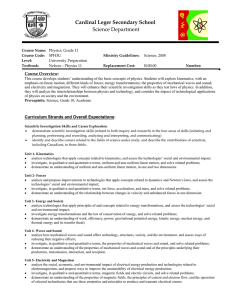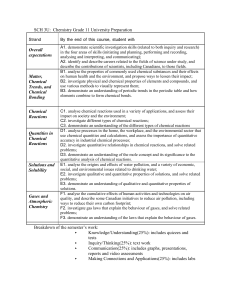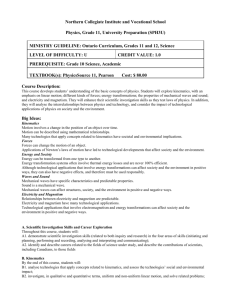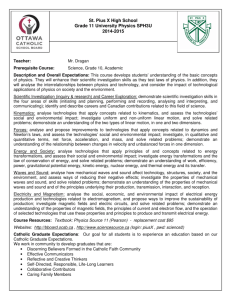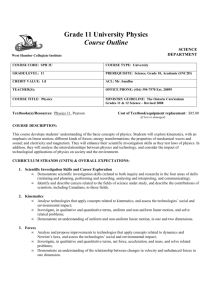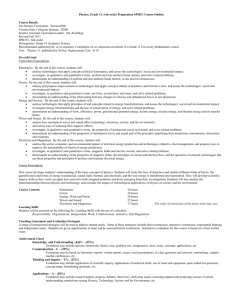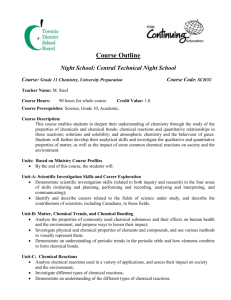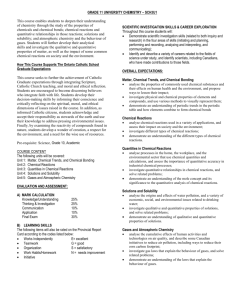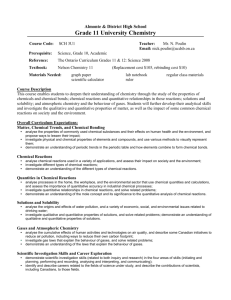Grade 11 Physics Syllabus - Gananoque Secondary School
advertisement
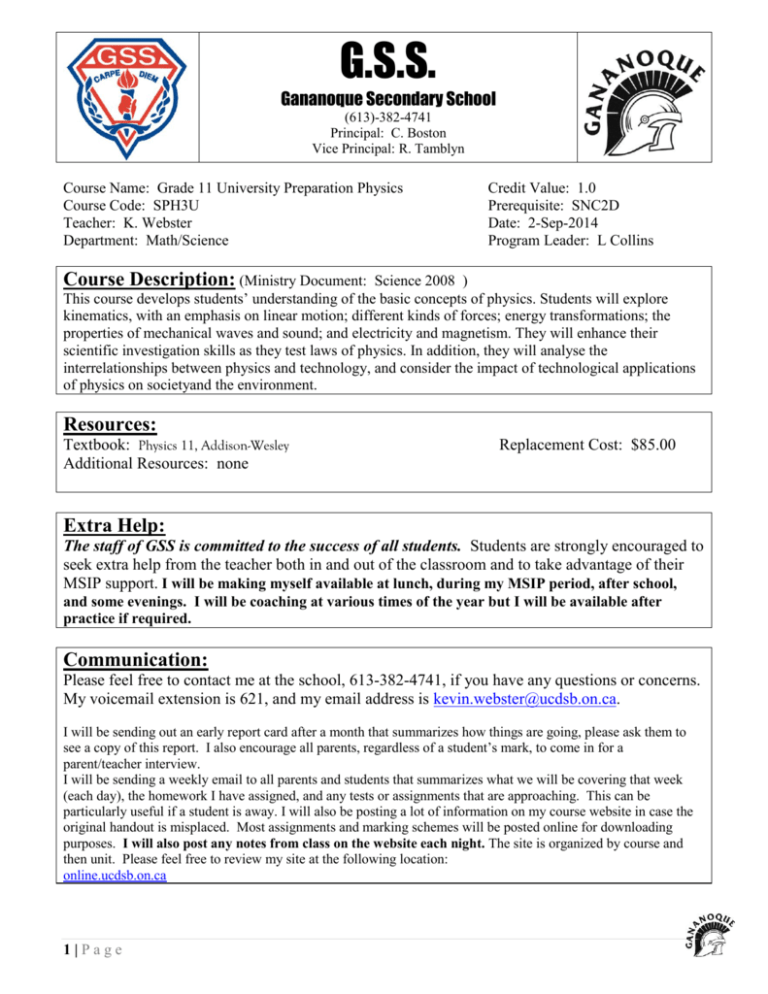
G.S.S. Gananoque Secondary School (613)-382-4741 Principal: C. Boston Vice Principal: R. Tamblyn Course Name: Grade 11 University Preparation Physics Course Code: SPH3U Teacher: K. Webster Department: Math/Science Credit Value: 1.0 Prerequisite: SNC2D Date: 2-Sep-2014 Program Leader: L Collins Course Description: (Ministry Document: Science 2008 ) This course develops students’ understanding of the basic concepts of physics. Students will explore kinematics, with an emphasis on linear motion; different kinds of forces; energy transformations; the properties of mechanical waves and sound; and electricity and magnetism. They will enhance their scientific investigation skills as they test laws of physics. In addition, they will analyse the interrelationships between physics and technology, and consider the impact of technological applications of physics on societyand the environment. Resources: Textbook: Physics 11, Addison-Wesley Additional Resources: none Replacement Cost: $85.00 Extra Help: The staff of GSS is committed to the success of all students. Students are strongly encouraged to seek extra help from the teacher both in and out of the classroom and to take advantage of their MSIP support. I will be making myself available at lunch, during my MSIP period, after school, and some evenings. I will be coaching at various times of the year but I will be available after practice if required. Communication: Please feel free to contact me at the school, 613-382-4741, if you have any questions or concerns. My voicemail extension is 621, and my email address is kevin.webster@ucdsb.on.ca. I will be sending out an early report card after a month that summarizes how things are going, please ask them to see a copy of this report. I also encourage all parents, regardless of a student’s mark, to come in for a parent/teacher interview. I will be sending a weekly email to all parents and students that summarizes what we will be covering that week (each day), the homework I have assigned, and any tests or assignments that are approaching. This can be particularly useful if a student is away. I will also be posting a lot of information on my course website in case the original handout is misplaced. Most assignments and marking schemes will be posted online for downloading purposes. I will also post any notes from class on the website each night. The site is organized by course and then unit. Please feel free to review my site at the following location: online.ucdsb.on.ca 1|Page Assessment & Evaluation – Ministry of Education’s Fundamental Principles: The primary purpose of assessment and evaluation is to improve student learning. To ensure that assessment, evaluation, and reporting are valid and reliable, and that they lead to the improvement of learning for all students, teachers use practices and procedures that: are fair, transparent, and equitable for all students; support all students, including those with special education needs, those who are learning the language of instruction (English or French), and those who are First Nation, Métis, or Inuit; are carefully planned to relate to the curriculum expectations and learning goals and, as much as possible, to the interests, learning styles and preferences, needs, and experiences of all students; are communicated clearly to students and parents at the beginning of the school year or course and at other appropriate points throughout the school year or course; are ongoing, varied in nature, and administered over a period of time to provide multiple opportunities for students to demonstrate the full range of their learning; provide ongoing descriptive feedback that is clear, specific, meaningful, and timely to support improved learning and achievement; develop students’self-assessment skills to enable them to assess their own learning, set specific goals, and plan next steps for their learning. Learning Skills: Teachers use their professional judgment to provide authentic and relevant opportunities to help students develop their learning skills and work habits. The student: Responsibility Organization Independent Work Collaboration Initiative Self-Regulation 2|Page Fulfils responsibilities and commitments within the learning environment. Completes and submits class work, homework, and assignments according to agreed-upon timelines. Takes responsibility for and manages own behaviour. The student: Devises and follows a plan and process for completing work and tasks. Establishes priorities and manages time to complete tasks and achieve goals. Identifies, gathers, evaluates, and uses information, technology, and resources to complete tasks. The student: Independently monitors, assesses, and revises plans to complete tasks and meet goals. Uses class time appropriately to complete tasks. Follows instructions with minimal supervision. The student: Accepts various roles and an equitable share of work in a group. Responds positively to the ideas, opinions, values, and traditions of others. Builds healthy peer-to-peer relationships through personal and media-assisted interactions. Works with others to resolve conflicts and build consensus to achieve group goals. Shares information, resources, and expertise, and promotes critical thinking to solve problems and make decisions. The student: Looks for and acts on new ideas and opportunities for learning. Demonstrates the capacity for innovation and a willingness to take risks. Demonstrates curiosity and interest in learning. Approaches new tasks with a positive attitude. Recognizes and advocates appropriately for the rights of self and others. The student: Sets own individual goals and monitors progress towards achieving them. Seeks clarification or assistance when needed. Assesses and reflects critically on own strengths, needs, and interests. Identifies learning opportunities, choices, and strategies to meet personal needs and achieve goals. Perseveres and makes an effort when responding to challenges. G.S.S. Gananoque Secondary School Course Name: Grade 11 University Preparation Physics Course Code: SPH3U Overall Course Expectations: (See table “Learning/Summative Tasks” for corresponding evaluation tools) Electricity and Magnetism Waves and Sound Energy and Society Forces Kinematics OVERALL EXPECTATIONS A1. demonstrate scientific investigation skills (related to both inquiry and research) in the four areas of skills (initiating and planning, performing and recording, analysing and interpreting, and communicating); A2. identify and describe careers related to the fields of science under study, and describe the contributions of scientists, including Canadians, to those fields. B1. analyse technologies that apply concepts related to kinematics, and assess the technologies’ social and environmental impact; B2. investigate, in qualitative and quantitative terms, uniform and nonuniform linear motion, and solve related problems; B3. demonstrate an understanding of uniform and non-uniform linear motion, in one and two dimensions. C1. analyse and propose improvements to technologies that apply concepts related to dynamics and Newton’s laws, and assess the technologies’ social and environmental impact; C2. investigate, in qualitative and quantitative terms, net force, acceleration, and mass, and solve related problems; C3. demonstrate an understanding of the relationship between changes in velocity and unbalanced forces in one dimension. D1. analyse technologies that apply principles of and concepts related to energy transformations, and assess the technologies’ social and environmental impact; D2. investigate energy transformations and the law of conservation of energy, and solve related problems; D3. demonstrate an understanding of work, efficiency, power, gravitational potential energy, kinetic energy, nuclear energy, and thermal energy and its transfer (heat). E1. analyse how mechanical waves and sound affect technology, structures, society, and the environment, and assess ways of reducing their negative effects; E2. investigate, in qualitative and quantitative terms, the properties of mechanical waves and sound, and solve related problems; E3. demonstrate an understanding of the properties of mechanical waves and sound and of the principles underlying their production, transmission, interaction, and reception. F1. analyse the social, economic, and environmental impact of electrical energy production and technologies related to electromagnetism, and propose ways to improve the sustainability of electrical energy production; F2. investigate, in qualitative and quantitative terms, magnetic fields and electric circuits, and solve related problems; F3. demonstrate an understanding of the properties of magnetic fields, the principles of current and electron flow, and the operation of selected technologies that use these properties and principles to produce and transmit electrical energy. Assessment & Evaluation Tools: 1 2 3 4 5 * 6 7 * 8 C/ A 9 10 11 12 C/ A * * * * * * * * * * * * * * * * * * * * * * * * * * * The primary purpose of assessment and evaluation is to improve student learning. The assessments will cover the four areas of the achievement chart, namely 1) Knowledge & Understanding, 2) Thinking & Inquiry, 3) Communication, 4) Application 3|Page 13 C/ A G.S.S. Gananoque Secondary School Course Name: Grade 11 University Preparation Physics 1. 2. Motion Investigation Unit 1 Test 6. 7. 3. Newton’s 2nd Law Lab 8. 4. Career Exploration Report Unit 2 Test 9. 5. Final Mark: 10. Course Code: SPH3U Learning / Summative Tasks (Numbers correspond to Course Expectations table) Pulley Lab 11. Unit 5 Test Unit 3 Test 12 Physics in movies CA Motor Project 13 Exam CA Unit 4 Test Instrument Project Assessing, evaluating and reporting on the demonstration of learning skills and work habits is separate from the achievement of curriculum expectations and should not be considered in the determination of a student’s grade. The final grade will be determined as follows: Term work: 70% Culminating Activities: 30% Culminating Activities in this course include: 20% Final Exam 10% Physics in movies and will be conducted on the following dates: Exam – Exam Period Physics in Movies – Throughout the term 4|Page
